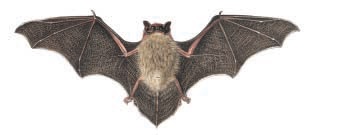It’s a small bat, with short and pointy ears; the hair is reddish brown on the back and paler ventrally. The name comes from the whitish band in the rear margin of the wing.
The albolimbato bat has agile, fast flight and great maneuverability in small spaces.
The species is anthropophilic or linked to the inhabited centers. As shelters, both summer and winter, the bat often chooses cavities in the buildings (cellars, drawers, cracks in the walls), cavities in the trees or in the hollow concrete poles. It is also found in agricultural areas and near bodies of water; it hardly occupies very extensive forest areas.
The albolimbato bat prefers areas of low and medium altitude; normally it does not go beyond the 1000 m of altitude.
Hibernation begins in November and ends in March-April. During hibernation, we can observe these animals flying outdoor during breaks.
The matings take place between August and October. This bat normally forms breeding colonies of a few specimens (around 20), composed essentially of females. Nurseries have the peculiarity of being almost perfectly silent, even if there are children.
The births take place between May and July; the twin births are very frequent. The young become independent after two months.
The preys are usually flying insects of various types that are caught under the streetlights, in the gardens, near the foliage of the trees or above the surface of the water. Catches shall normally not exceed 5 m in height.
The species is much affected by the loss of shelters, due to the construction and restoration techniques that tend to eliminate the potential shelters in the buildings. Another risk factor is the direct disturbance caused to the colonies by unjustified fears and superstitions.
The species is included in Annex IV of the Habitats Directive 92/43/EEC.

